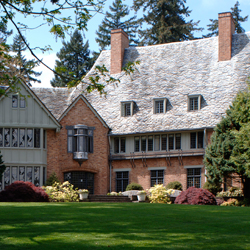Lewis & Clark earns top honors for best facilities management
Open gallery

Lewis & Clark has earned a BetterBricks Award from the Northwest Energy Efficiency Alliance for the college’s efforts to reduce energy consumption through effective facilities management. The BetterBricks initiative recognizes the efforts of professionals such as architects and facilities managers to design and operate high-performance buildings and energy efficiency programs throughout the Northwest.
Research shows that buildings consume more than 40 percent of the energy used in the U.S., and approximately half of that figure is used in the commercial sector. Despite increasing its own building area by 41 percent since 1991, Lewis & Clark has reduced its annual electricity and natural gas consumption, and reduced its total gross greenhouse gas emissions by 27 percent—and, if offsets are included, by 36 percent.
Richard Bettega, associate vice president for facilities, attributed the college’s success to three important factors: quality monitoring systems, innovative partnerships, and support from campus community stakeholders.
“We are interested in building systems to monitor our energy consumption that are easy for people to use and that provide data that help us identify ways to create greater energy efficiency,” Bettega said. “The feedback loop of data collection, data sharing, and analysis is critical to our work.”
For example, Lewis & Clark maintains an energy management system that provides real-time feedback on every building’s operation, while also allowing for remote accessibility. Electricity and natural gas meters are installed on nearly every building, providing important energy-use data to staff and students. With the help of facilities management, student residents initiated a four-week energy conservation competition in residence halls in 2010, with the express purpose of illustrating that saving energy is as much about behavior as it is about technological solutions.
Such energy efficiency partnerships extend off campus, as well. In 2008, Lewis & Clark launched a renewable energy project with Honeywell International to build a solar panel system on the roof of the Pamplin Sports Center that generates 100 KW annually, the equivalent of approximately 15 percent of the electricity needs for the sports facility. The project marked the first time a corporation and college had collaborated on a renewable energy project in Oregon.
“We simply wouldn’t be successful at our efforts at energy efficiency were it not for the commitment of the entire college,” Bettega said. “The hard work of our facilities crew, the passion of our students and faculty, and the support of the executive leadership all add up to a winning combination for greater efficiency and a more sustainable future.”
Learn more about the solar panel project developed by Lewis & Clark in partnership with Honeywell International.
More Newsroom Stories
Public Relations is located in McAfee on the Undergraduate Campus.
MSC: 19
email public@lclark.edu
voice 503-768-7970
Public Relations
Lewis & Clark
615 S. Palatine Hill Road MSC 19
Portland OR 97219

